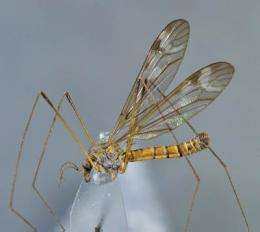DNA barcoding verified the discovery of a highly disconnected crane fly species

Northwestern Europe harbors one of the best known biotas, thanks to the long faunistic and floristic traditions practiced there. However, some animal groups are far better known than others. The diversity of true flies there is fascinating, and undescribed species of flies, midges and gnats are not uncommon. Because Northwestern Europe was almost totally glaciated as recently as 10 000 years ago, endemic animal species of that region are generally lacking, or are exceptions. Hence, most NW European insects and other species have colonized the area following the withdrawal of ice.
The new crane fly species Tipula recondita, is not an exception. It was found on both extremes of the vast Eurasian continent, in Northern Finland (Kittilä) as well as in the Russian Far East (Primorski kray). The description was published in the open access journal ZooKeys.
PhD candidate Jukka Salmela, working in the Zoological Museum in Turku (Finland), thinks that the new species is most likely a very rare one, because the Finnish fauna has been intensively studied during the 2000s. The rarity of the species is perhaps caused by its association with the increasinlgy rare old-growth forests and / or calcareous herb-rich forests of the taiga. Both old-growth forests with large amounts of decaying trees and northern herb-rich forests are rare habitats in Northwestern Europe.

In addition to morphology, DNA barcoding was used to assess the status of the new species. Intraspecific genetic distance between Finnish and Russian populations was small, verifying the idea of a single but disjunct species; geographic distance of the populations is over 6500 km. Moreover, based on morphology and DNA, the new species is clearly separated from closely related species. "The sequencing result was expected, because among crane flies, there are some other wide-ranging and disjunct species, e.g. Tipula kaisilai and T. subexcisa. These disjunct populations may be relicts from climatically more favourable periods, when these species were more widespread. On the other hand, it can't be excluded that some disjunct species are more common than we currently know; the efforts directed at collecting them may simply have been too low to reveal their true ranges. However, both DNA and morphology suggest that the Finnish and Russian populations belong to the same species", said Salmela. "The next step is to map the occurrence of the species in NW Europe and arrive at a better understanding of its ecology; a larva or two would be nice to catch", Salmela added.
More information: Pilipenko VE, Salmela J, Vesterinen EJ (2012) Description and DNA barcoding of Tipula (Pterelachisus) recondita sp. n. from the Palaearctic region (Diptera, Tipulidae). ZooKeys 192: 51-65. doi: 10.3897/zookeys.192.2364
Journal information: ZooKeys
Provided by Pensoft Publishers
















